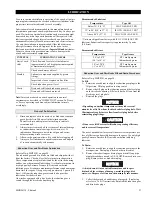
26
MHD56114 - Edition 4
Disassembly
General Disassembly Instructions
The following instructions provide the necessary information to
disassemble, inspect, repair, and assemble the winch. Parts
drawings are provided in the Parts Section.
If a winch is being completely disassembled for any reason,
follow the order of the topics as they are presented.
It is recommended that all maintenance work on the winch be
performed in a clean dust free work area.
In the process of disassembling the winch, observe the following:
1.
Never disassemble the winch any further than is necessary to
accomplish the needed repair. A good part can be damaged
during the course of disassembly.
2.
Never use excessive force when removing parts. Tapping
gently around the perimeter of a cover or housing with a soft
hammer, for example, is sufficient to break the seal.
3.
Do not heat a part with a flame to free it for removal, unless
the part being heated is already worn or damaged beyond
repair and no additional damage will occur to other parts.
In general, the winch is designed to permit easy disassembly and
assembly. The use of heat or excessive force should not be
required.
4.
Keep the work area as clean as practical, to prevent dirt and
other foreign matter from getting into bearings or other
moving parts.
5.
All seals, gaskets and ‘O’ rings should be discarded once
they have been removed. New seals, gaskets and ‘O’ rings
should be used when assembling the winch.
6.
When grasping a part in a vise, always use leather-covered
or copper-covered vise jaws to protect the surface of the part
and help prevent distortion. This is particularly true of
threaded members, machined surfaces and housings.
7.
Do not remove any part which is a press fit in or on a
subassembly unless the removal of that part is necessary for
repairs or replacement.
8.
When removing ball bearings from shafts, it is best to use a
bearing puller. When removing bearings from housings,
drive out the bearing with a sleeve slightly smaller than the
outside diameter of the bearing. The end of the sleeve or
pipe which contacts the bearing must be square. Protect
bearings from dirt by keeping them wrapped in clean cloths.
Drum Guard Disassembly (optional feature)
Refer to Dwg. MHP2512 on page 62.
1.
Remove capscrews (592).
2.
Remove brackets (591) and/or (595) by sliding out of drum
guard (590).
3.
Carefully remove drum guard (590) from rear (drum brake
side) side rail (64). By design the drum guard attaches to the
side rail using tabs. The smaller, upper tabs are visible on the
top of the side rail. The longer, lower tab is located beneath
the side rail edge. During removal care must be taken not to
bend the tabs. To correctly remove, at the point where the
drum guard and the side rail meet, push, or tap the lower
portion of the drum guard in towards the winch drum (62).
The direction of force should be directly away from the side
rail. Do not pull ‘up’ or ‘down’ as the tabs may become
deformed.
Winch Disassembly
Refer to Dwg. MHP0950 on page 40.
1.
Remove wire rope from the drum (62). Remove wire rope
anchor (63) and store for reassembly.
2.
Relieve pressure in the air lines and winch air components
by operating the winch control several times after the air
supply has been turned off.
WARNING
• Shut off, bleed down and disconnect the air supply line
before performing any disassembly procedures.
3.
Disconnect and tag the air lines.
4.
To drain oil refer to “LUBRICATION” section.
5.
Remove the fasteners securing winch to its foundation and
move the winch to a suitable work area before beginning
disassembly.
WARNING
• The air motor weighs approximately 260 lbs. (118 kg).
Adequately support the air motor before removing the motor
mounting capscrews.
6.
Remove the ten capscrews (197) and lockwashers (196)
securing the motor assembly to the motor adapter (71). Using
a hoist to support the motor, pull the motor straight away
from the winch. Refer to the ‘Motor Disassembly’ section if
motor disassembly is required.
7.
Remove drive shaft (61) and coupling (60).
8.
If equipped, disconnect the drum band brake.
Manual Drum Brake:
Refer to Dwg. MHP1402 on page 47.
a.
Remove cotter pin (139) and pin (138).
b.
Loosen capscrew (130) and allow cam stop (132) to
rotate freely.
c.
To disassemble further, refer to ‘Manual Band Brake
Disassembly’ section.
Automatic Drum Brake:
Refer to Dwg. MHP2508 on page 46.
a.
Remove capscrews (101), spacers (102) and (103).
b.
Remove and save spacer (105).
c.
Loosen two nuts (117).
d.
Remove capscrew (120) from plunger (114). Lower jam
nut (117) will not be removed, it is bonded to capscrew
(120).
e.
To disassemble further, refer to ‘Automatic Band Brake
Disassembly’ section.
9.
Remove any other externally mounted winch attachments.
Refer to the applicable section for disassembly instructions.
Содержание FA2.5A Series
Страница 38: ...MHD56114 Edition 4 37 SERVICE NOTES...
Страница 70: ...MHD56114 Edition 4 69 SERVICE NOTES...
Страница 71: ...70 MHD56114 Edition 4 SERVICE NOTES...






























